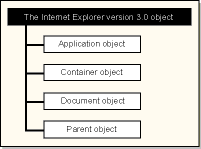
The Internet Explorer version 3.0 object model is flat—that is, it has only one level. In this respect it is unlike many other object models. The single-level architecture of the Internet Explorer model makes it significantly easier to master than many other applications. Figure 3-4 shows the complete Internet Explorer object model, and Tables 3-1 and 3-2 describe the object's properties and methods.

Figure 3-4.
The Internet Explorer object model.
Table 3-1.Properties of the Microsoft Internet Explorer, Version 3.0
| Property | Type | Description | Usage |
| Application | Object | Returns a reference to the Internet Explorer object. | Set MyObject = browser.Application |
| Busy | Boolean | Returns a boolean value indicating whether the Internet Explorer is busy downloading data or performing some other activity. True indicates busy; False indicates not busy. | If browser.Busy Then…EndIf |
| Container | Object | Returns a reference to the container/parent of the Internet Explorer, if any exists. | Set MyObject = browser.Container |
| Document | Object | Returns a reference to the active document, if any exists. | Set MyDocument = browser.Document |
| FullName | String | Returns the full pathname to the Internet Explorer executable. (Example: C:\PROGRAM FILES\Plus!\MICROSOFT INTERNET\IEXPLORE.EXE) | MsgBox browser.FullName |
| FullScreen | Boolean | Returns or sets the Internet Explorer window mode. True indicates that the window is maximized and that the status bar, toolbar, menu bar, and title bar are hidden. | If browser.FullNameThen…EndIf browser.FullScreen = True |
| Height, Width | Long | Returns or sets the dimensions in pixels of the Internet Explorer window. | MsgBox browser.Height browser.Height = 400 |
| HWND | Long | Returns the window handle MsgBox of the current Internet Explorer window. | browser.HWND |
| Left, Top | Long | Returns or sets the position in pixels of the Internet Explorer window relative to the screen/container. | MsgBox browser.Left browser.Left = 100 |
| LocationName | String | Returns the name of the file currently being viewed. (Example: Microsoft Corporation) | MsgBox browser.LocationName |
| LocationURL | String | Returns the full URL for the file currently being viewed. (Example: http://www.microsoft.com/) | MsgBox browser.LocationURL |
| MenuBar | Boolean | Returns or sets the display of If the menu bar. True indicates that the menu bar is visible; False indicates that it is hidden. | browser.MenuBar Then…EndIf browser.MenuBar = True |
| Name | String | Returns the name of the Internet Explorer application. (Example: Microsoft Internet Explorer) | MsgBox browser.Name |
| Parent | Object | Returns a reference to the container/parent of the Internet Explorer. | Set MyObject = browser.Parent |
| Path | String | Returns the full pathname to the Internet Explorer application. (Example: C:\PROGRAM FILES\PLUS!\MICROSOFT INTERNET\) | MsgBox browser.Path |
| StatusBar | Boolean | Returns or sets the display of the status bar. True indicates that the status bar is visible; False indicates that it is hidden. | If browser.StatusBar Then…EndIf browser.StatusBar = True |
| StatusText | String | Returns or sets the text for the status bar. | MyString = browser.StatusText browser.StatusText = MyString |
| ToolBar | Long | Returns or sets which toolbar is shown. For example, 0 indicates no toolbar; 1 indicates the default toolbar. | MsgBox browser.toolbar browser.toolbar = 1 |
| TopLevelContainer | Boolean | Returns a Boolean value indicating whether the current object is the top-level container. True indicates that the object is the top-level container; False indicates that it is not. | If browser. TopLevelContainer Then…EndIf |
| Type | String | Returns the type of document in the Internet Explorer. | MyType = browser.Type |
| Visible | Boolean | Returns or sets the display of the Internet Explorer. True indicates that the Internet Explorer is visible; False indicates that it is hidden. | If browser.Visible Then…EndIf browser.Visible = True |
Table 3-2.Methods of the
Microsoft Internet Explorer, Version 3.0
| Method | Description | Usage |
| ClientToWindow(pcx, pcy) | Converts client sizes into window sizes. pcx and pcy are defined as long. | |
| GetProperty (szProperty) |
Returns the value for the specified property. szProperty is defined as a string. | |
| GoBack, GoForward | Used to navigate the Internet Explorer, based on values in the history list. | browser.GoBack |
| GoHome, GoSearch | Used to navigate the Internet Explorer. | browser.GoHome |
| Navigate (URL [, Flags] [, TargetFrameName] [, PostData] [, Headers]) | Jumps to the specified URL. is one of the following constants or values: navOpenInNewWindow=1 navNoHistory=2 navNoReadFromCache=4 navNoWriteToCache=8 TargetFrameName is a string that specifies the name of the frame in which results will be displayed. PostData is the data to send with the HTTP post transaction. Headers is a value that specifies the HTTP headers to send. | Flags browser.Navigate ("http://www.vb-bootcamp.com") |
| PutProperty(szProperty, vtValue | Sets the property to the specified vtValue) value. szProperty is defined as a string and is defined as a variant. | |
| Quit | Exits the Internet Explorer application and closes the open document. | browser.Quit |
| Refresh | Refreshes the current document. | browser.Refresh |
| Refresh2 [Level] | Refreshes the current document. Level is one of the following constants or values: REFRESH_NORMAL=0 REFRESH_IFEXPIRED=1 REFRESH_CONTINUE=2 REFRESH_COMPLETELY=3 | browser.Refresh2(0) browser. Refresh2(REFRESH_NORMAL) |
| Stop | Stops loading the current document. | browser.Stop |